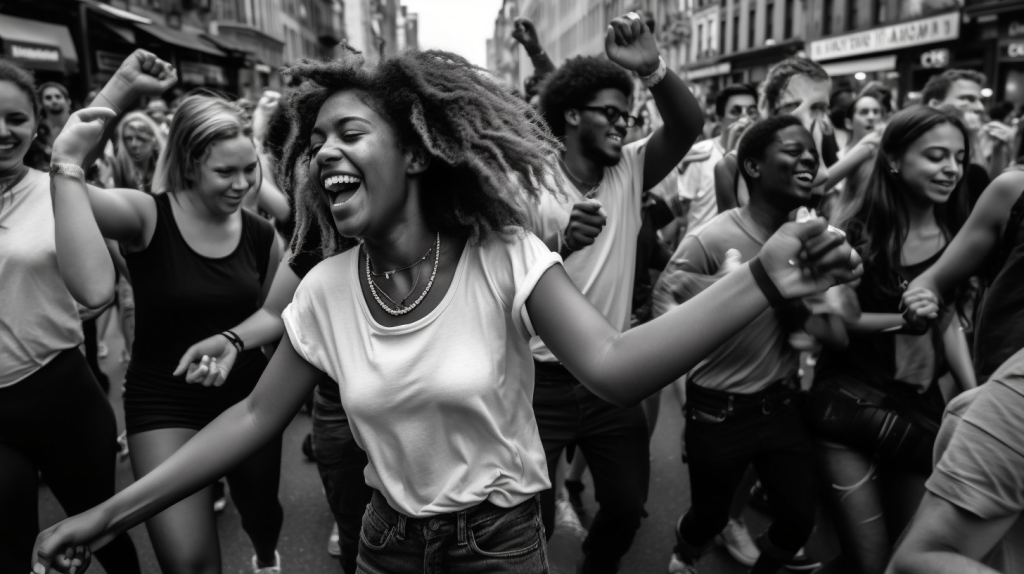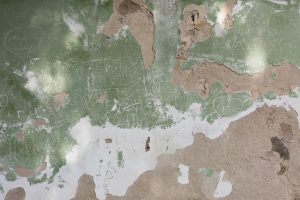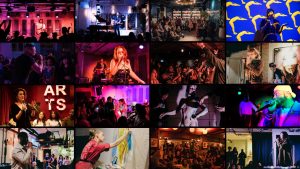“To be hopeful means to be uncertain about the future,” said Rebecca Solnit — and if the Great Toilet Paper Panic of 2020 is anything to go by, it’s an ethos we could all do with embracing more. But how do we detach from the maelstrom of fear and division, turn our eyes away from this long running “theatre of the absurd” that is mainstream society, to arrive at a state where we can embrace uncertainty and collaborate to find solutions? The answer lies, in the science of resilience & mirror neurons — and bringing everything back to the smallest building block of society: the human. In this way, we can create resilient communities and businesses.
My work as a professional fixer, business consultant, and creative director required I look deeply at the human, and the interface between our anatomy and the soul to find ways to protect the human at the heart of all value creation and society. I found a source of hope buried deep within our brains: we are hardwired for empathy using something called mirror neurons.
This insight culminated in creating a hybrid entity called, What Does Not — a culture agency and creative incubator, that combines the functions of an events company, creative agency, and community. Building empathy, and therefore social capital, has permeated everything we’ve done for the public, and now, as we turn our sights to private and public sector, we’re gearing up to turn the terms ‘social impact’ and ‘DEI’ into drivers of innovation and sources of longevity — not just box ticking exercises.
Now, as we look to scale up, it’s time to change the channel and live through what I call, ‘the theatre of resilience:’ What Does Not’s vision and engine for change, where all segments of society play their part in overwriting doomsday narratives. In the process, we’re redefining ‘immersive culture programming’ to encompass everything from IRL activations, content marketing, CX, workforce development, company culture consulting, as well as innovative approaches to collaboration and product development. It’s a good time for it too.
In unstable times, people seek simple solutions, purpose and community. We had better give them this, at scale — and fast — if we’re going to curtail the flocking of people toward the far right where they can find these 3 things in abundance. And the fastest way to do it is to harness the public’s addiction to consuming content, and the influence of brands.
What’s the story?
What Does Not was created with the ethos of resilience running through it. After all, the name comes from the aphorism ‘what does not kill you makes you stronger’. Karl Marx was wrong about many things, but he was right about alienation, a core symptom of capitalism — and a sentiment echoed by Britney Spears when she sang ‘my loneliness is killing me’. Jokes aside, the technological interconnectedness and the increasing interpersonal separation are defining features of the age we’re living through.
To repair the social fabric that’s been torn apart by business models unfit for the running of society (ie capitalism), we have to repair the warp and weft that’s made up of social relationships. To do that we need empathy if we’re going to come near to anything resembling a harmonious and sustainable future. And so, everything we do is coded with the science of mirror neurons into its DNA, so you can literally programme the human for collaboration and care, instead of fear and division.
Because as much as we’d like empathy to be innate to all humans, it just doesn’t come as naturally to some. Even for those whose heart naturally bleeds, the strain of the daily grind can numb feelings of empathy. And if the antidote to this age of division, extraction and aggressive competition is cohesion and mutually-beneficial collaboration, the question is, how can we cultivate kindness and build strong, collaborative, empathic social relationships on a larger scale? Cue What Does Not.
Mirror neurons: The empathy enablers and social connectors
So what are mirror neurons? Well, they’re cells that send and receive messages between our body and our brain. They govern learning through observation and imitation — and are responsible for both the “what” and the “what for” of a particular action — hence being strongly linked to our ability to show empathy, and resonate with the emotions and experiences of those around us. This mirroring is the empathy enabler and the key to bridging the gap between the self and others, forming bonds and strengthening connections.
From ‘If it bleeds, it leads’ to ‘If it inspires, it transpires’
For us, immersive doesn’t mean big screens and VR headsets. It means recognising that humans are culture, and that the 5 senses are in dialogue with the brain — so we create multi-layered experiences that surface diverse perspectives, helping people step into the other’s shoes so as to gain a deeper appreciation of their struggles and aspirations. We examine issues from many angles, facilitate genuine human connection, provoke thought and build resilience in the process.
The reactions that get stimulated make these mirror neurons come alive. We activate them through creating safe spaces of common ground — where the universal language of music, food, and stories facilitate an understanding of our shared humanity.
There’s a reason What Does Not is a self styled culture agency and creative incubator. We want to change the norms of co-working, co-living, and co-existing — so that we no longer do things from a place of obligation, but from a place of inspiration. Our gamble is that healthy, happy humans will create a healthy, happy culture.
This is key to the creative incubator side of WDN… Connection and inspiration leads to hopeful dreaming and collaboration. In a way, we are creating a new ethos, and virtuous cycle, for content creation and content consumption: “if it inspires, it transpires.” Scaled up, this is change-making, culture-shifting, zeitgeist-defining stuff. Because every product and service spawns ‘content’ as an inevitability of the modern world — and you can harness this pattern of behaviour to influence the supply as well as the demand for whatever you make.
If we go by the high global rates of suicide (the WHO lists it as a leading cause of death among humans ahead of HIV, malaria or breast cancer, war and homicide), the phenomenon of the Great Resignation, and the sheer number of businesses that began as ‘lockdown projects’ we know for sure, people have had enough of living a life of misery.
“Resilience is the ability of a system (like a community) to absorb disturbance and still retain basic function and structure. Building resilience means intentionally guiding the system’s process of adaptation in an attempt to preserve some qualities and allow others to fade away, all while retaining the essence — or “identity” — of the system. In a human community, identity is essentially determined by what people value about where they live.”
Daniel Lerch, Post Carbon Institute
What’s in the tin?
You’ve read what it says on the tin, but what’s in it? Quite simply, finding different ways to discover our shared identity and unite around shared interests. This looks like What Does Not’s uncensored storytelling nights, the RAW, which helps people discover their shared humanity. Each one is centred around a theme, and we curate it in a way that helps people discover different lenses on that topic.
Then there’s the NOISE, our emerging music showcase meets open jam, unites people through a love of shared interests — in this case music and dance.
And finally, there’s the POV, What Does Not’s panels with a difference. This takes themes arising from the RAWs and helps people contextualise the age we live in, so they can process how their personal experience — from dating, to sex, and relationships — is connected to the whole. In short, we are not an atomised society. We are an organism called humanity, and we’re having a bit of a moment. But we will overcome.
Going from B2C to B2B in resilience building
Democratising the science of resilience and making it fun for the public has worked like a charm. Now, it’s time for business to become a force for good in the most tangible way possible: by impacting the human. Those that work for them, and those that buy into their mission.
With the advent of AI and the scramble to implement it across all areas of life and business processes, we need to focus on the human more than ever. And not just because the cookieless future (the abolition of 3rd party cookies on browsers) demands we deeply understand human behaviour.
With some brands commanding allegiances bigger than some nations (e.g. Apple and Nike), the fastest way to create a global culture of kindness and collaboration is for organisations everywhere to align their goals with this vision: culture programming as the machete that cuts through the noise of division and fear.
These are not just wooly aspirations. My professional history as a one-woman-McKinsey-meets-Ogilvy-band — and that of my core team in large scale digital product design & development, and in events / company culture for one of the largest Hollywood studios — has led me to believe this type of work is more critical than ever. We can talk about DEI, inclusive / user centred design and design thinking, until we’re blue in the face — but none of those things have moved the dial on our current culture of division and disconnection that exists within companies too.
Employee satisfaction in almost all the places I consulted was pretty low. In the process of diagnosing the problem, rolling up my sleeves, restructuring the company, fixing, recruiting, motivating, inspiring, developing and building, you could say I got to know each business pretty well. Hierarchical structures meant authority cannot be held to account. Implementing flat structures almost never worked, because this is applied as a business model and not as an imperative stemming from the desire to fulfil basic human needs. And so the same problems persisted.
This not only impacts performance, morale and productivity. It affects the ability to innovate, adapt, be resilient to market shocks — and ultimately, the bottom line.
Now playing in the theatre of resilience: journeys not destinations
If I had a penny for the amount of times clients wanted to make an app to solve a real, human problem — I’d be bigger than Elon. The truth is, when you rehumanise internal processes and solve for the human, your products and services naturally come together in a CX-focused (customer experience) way — both internally and externally.
Government is a great example of this. The world over, technology is being excessively emphasised as a panacea to societal issues. COVID is tearing through society? Make a digital passport that may lead to segregation? Why the hell not.
Or, if I could, I’d change the channel to play a narrative of togetherness and collaboration, as society and government work together to navigate through a time of crisis. In this show, everyone’s concerns are heard, everyone is represented, no one has the answer — but together we’re working to find it. That’s a show I’d watch.
When you remove the rush to design tech for a human problem, you may actually solve the real issues. In society these are: distrust of authority, fear of the unknown, scrutiny by the media. While on the inside of government we have: a patchwork of fiefdoms, a deeply rooted culture of inter-departmental territorialism that prevents collaboration — and leads to building the wrong thing because of pressure to ‘feed the dev teams’. In short, it’s more cost-efficient and socially effective to change the ‘tech-first’ mental model. And approach challenges as behaviour change projects that contain a technology element as part of overcoming crisis.
“The most remarkable feature of this historical moment on Earth is not that we are on the way to destroying the world — we’ve actually been on the way for quite a while. It is that we are beginning to wake up, as from a millennia-long sleep, to a whole new relationship to our world, to ourselves and each other. [Our job now] is to help people uncover and experience their innate connections with each other and with the systemic, self-healing powers of the web of life, so that they may be enlivened and motivated to play their part in creating a sustainable civilization.”
Joanna Macy, Environmentalist
McKinsey’s digital arm recently wrote about ‘Inclusive design as a path to resiliency and growth.’ While they’re bang on the money about the fact inclusivity puts resilience into products and services, they represent the extractive mindset that’s destroyed the world, seeing the marginalised and the overlooked as a market opportunity worth $12 trillion.
I’ll tell you something else for free that big consultancies won’t. ‘Inclusive design’ is about to be the next buzzword in a string of methodologies that didn’t quite hit the mark. As enterprise resilience (defined as an organisation’s capacity to anticipate and react to change not only to survive, but to evolve) takes on increasing strategic importance for navigating these rollercoaster times, there is no use trying to build resiliency into the design of products and services, without considering one very obvious roadblock to this noble intention: we live in the age of the attention economy.
So the question becomes, not how can we sell our shit to the hidden market of the disabled, the way McKinsey suggests. It’s how can we reach, and positively influence the distracted, the disconnected (from self and other), and the dispossessed? Isn’t the answer ‘you gotta make them FEEL something’? To make the invisible, palpable? The IRL, visceral? The impossible, seem possible? You see, when you solve for the human, you solve for every ‘X’. And the people feel it. Happy employees make better teams — they collaborate seamlessly. They have the mental space to see the way forward. They build better products. And deliver better services.
This is why I designed every event series to work as a B2B product, so businesses can easily be on the right side of history. As a B2B product, RAW is no longer a feelgood night out. It’s workforce development and team building. It facilitates flat structures by keeping authority in check — and in touch with reality.
The NOISE is not just a banging music event — it’s disrupting the entire music industry, it’s an incubator for music that catches the mood of the times, a zeitgeist-defining vehicle for broadcasting purposeful, culture messages.
The POV is not just a bunch of articulate people having a chat — it’s a way to shift the mindsets of an entire body of humans, sparking new perspectives and innovations, motivating them to work towards something bigger than themselves.
Now playing in the theatre of resilience: journeys not destinations
Sex sells. That’s why, at What Does Not, our go-to-market strategy has been to kick things off by working with some of the more “exclusive” brands out there. If we make something inaccessible, more accessible, people will clamour for it.
But, maybe because we’re an all-female team, there’s a heightened level of sensitivity that comes with everything we do — so we throw open the doors to people who would ordinarily not have access to the Soho Houses of this world. And we make a lot of these events free too. It’s the only way to truly activate the power of mirror neurons — to create a new type of social mixology that is very hard to come by.
We will not heal the rifts in society if we only socialise with those that are already like us. We have to bridge the divides and the niches of society if we are to turn the culture of aggression, division, consumption and individualism into one of respect, creativity, and equity, that fulfils our human potential, and protect our planet so we all thrive together.



